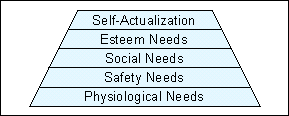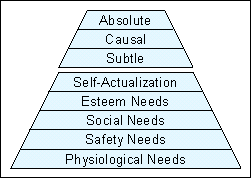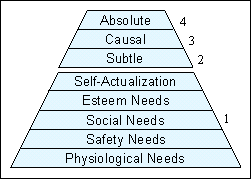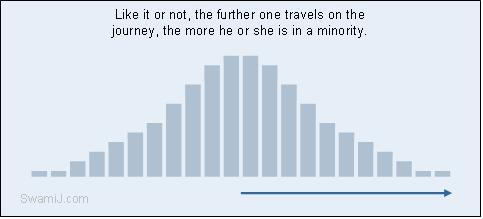|
|
Maslow's Needs Hierarchy
|
||
|
To appreciate this
article, it is necessary to understand |
Yoga is really about the mind and transcendence: In reading this article it is essential to understand that Yoga has been significantly misunderstood in recent years, leading people to believe that it is a physical exercise program. It is important to know this so that you can openly read about the relationship between Yoga Psychology and Psychology as we usually perceive it, particularly focusing here on Maslow's model of psychological development. Authentic Yoga, while possibly including bodily work as a foundation, is actually about encountering, examining, exploring, integrating and transcending the many levels, currents and crosscurrents of mind. (See also the article Modern versus Traditional Yoga)
Yoga Psychology is a developmental process: The comparison of the stages of Yoga Psychology to the stages of Maslow's Needs Hierarchy is being presented here as a way of explaining the nature of Yoga as a process of developmental self-awareness or unfoldment, which reaches still higher levels of human development or experience. Yoga Psychology deals with living in the world and also with transcendence into and through the higher reaches of human consciousness.
See also other related articles:
Levels of Consciousness and
Practice (Index of articles)
Maslow's Needs Hierarchy: Maslow explains that the human has five levels of needs, which build one upon the other. To develop a next higher level requires a reasonable level of completion, wholeness, integration, or stability at the previous level or levels. When this relative completion at a stage occurs, the desire or longing for the next higher level automatically emerges over time.

Maslow's Needs Hierarchy
Physiological Needs: These are the primary needs, which include the needs for food, water, air, and sleep. Without these, physical life itself is not possible.
Safety Needs: Once the physiological needs are met, there are the needs for safe lifestyle and safe environments. These might include safe housing, financial security, job security, as well as physical, mental, and emotional safety and freedom from threats.
Social Needs: Beyond the safety needs arise the needs for belongingness, such as having family, friends, and community. It involves the giving and receiving of love and nurturing.
Esteem Needs: With social needs intact, there comes the needs for self-respect, achievement, and recognition by others. Maslow later modified this somewhat, by explaining that between these Esteem needs and the need for Self-Actualization (below), there is also the need for aesthetics and knowledge.
Self-Actualization: The culmination of Maslow's original Needs Hierarchy is that of attaining one's full potential as a human being living in the world, involving the seeking and expression of justice, wisdom, benevolence, and creativity. This level of developmental recognition was a major cornerstone of the Humanistic Psychology movement, sometimes called the "third force" of psychology, following the "first force," which is depth psychology of the ego structure, and the "second force," which is behavioral psychology.
Maslow's Revised Needs Hierarchy: In his later years, Maslow added a sixth level to his Needs Hierarchy, that of Transcendence or Transpersonal. This was in recognition of realities that are "trans" or beyond all of the first five levels, including even the fifth stage of Self-Actualization. Transpersonal Psychology has become known as the "fourth force" of psychology.
It is interesting that while Maslow's Needs Hierarchy of five needs has become widely known, written about, and taught, there is very little written or spoken about his addition of the sixth level. Possibly it is not understood well enough to make it into most of the psychology, business, and other human development textbooks, magazines, or journals since few people develop to this level in their current incarnation.

Maslow's Revised Needs Hierarchy
It is very important to note that there is a great difference between the terms Self-Actualization and Self-Realization, with the former having to do with higher levels of fulfillment at the personality level, while still in relation to worldliness. Self-Realization has to do with that knowing of pure consciousness (or many other such terms), which is beyond, transcendent, or transpersonal (Self-Realization relates to the Absolute, the highest of the three additional levels described below).
Needs Hierarchy and Yoga Developmental Stages: According to Yoga Psychology, there are three additional levels of development, experience, or being, which are beyond the five primary needs. Eventually, even these three sequentially emerge as needs, as the longing for deeper and deeper truths intensifies.
Just as with Maslow's five stages, each of these are sought one after the other. At first, one might seek the Subtle, then realize that there is more, the expansive, formless insight of the Causal. Then, even that is desired to be transcended, seeking nothing less than the direct experience or realization of the Absolute Reality, Truth, or Self.

Needs Hierarchy and Yoga Developmental Stages
Those involved with or familiar with the Transpersonal Psychology movement may or may not recognize each of these additional three levels known to Yoga Psychology. What many consider the Transpersonal level of Maslow is equivalent to the Subtle level of Yoga Psychology. This may involve subtle, psychic, occult, or astral plane experiences, while not yet evolving or climbing the developmental ladder to that of the Causal or Absolute (These are further discussed below and in other articles introduced in the next section).
As with the earlier five levels of needs, there may not be much recognition of the higher levels when one is still working on a lower level. For example, just as one might not be working much on Social and Esteem needs when having no food, water, or safety, one who is extensively engaged in exploring the Subtle, psychic, astral, or occult planes may have little awareness or seeking of the Causal or Absolute. Similarly, one who is working on Esteem needs and Self-Actualization needs may not yet have much interest in Maslow's Transpersonal stage, much less the Causal or Absolute stages of Yoga, which, for such a person will likely not even be acknowledged as realities.
Four Developmental Stages of Yoga: Each of the five needs described by Maslow can be said to be all operating in one domain or level of reality. Collectively, these five are operating in the Gross level. Yoga contains a total of four broad levels or stages, though each of these might be further subdivided by some who describe these levels.

Four Developmental Stages of Yoga
1. Gross/Vaishvanara: All of the five stages of Maslow's Needs Hierarchy are experienced as part of the reality of the Gross world. The deeper levels (the other three levels of Yoga Psychology) are there, as the functioning substratum, but these are generally quite out of view by most people.
2. Subtle/Taijasa: The Subtle level or stage is also there as a substratum, which is typically out of view. This level of development is commonly known in our culture as experiences of the astral, occult, or psychic planes. The experiences and skills developed in this level are part of this developmental process.
3. Causal/Prajna: The Causal plane is seldom talked about or written about, even in the Transpersonal communities. It is the substratum out of which the Subtle and Gross spring. It is the fountain of intuitive and formless knowing, deeper than subtle experiences, visions, sounds, visitations, or voices.
4: Absolute/Turiya: This is called the "fourth" state (which is a different usage of the term "fourth" from that of the "fourth" psychology described above). Here, Turiya is that pure consciousness, which permeates and transcends the other three stages, including the five needs of the Needs Hierarchy, which are part of the Gross. Turiya also permeates and transcends both the Subtle and Causal levels.
To study and understand these four levels of reality and Developmental Yoga Psychology may take a good bit of effort, along with sincere practices of meditation and contemplation. It is highly significant and useful to note and remember that these four stages of Developmental Yoga Psychology are symbolically represented in the four parts of the OM Mantra. These four parts are the three sounds A, U, and M, along with the silence that follows. Included in the articles below is an article on OM Mantra that will explain this further. OM Mantra is not being introduced here to promote the chanting of the mantra, although that can be useful and pleasant. Rather, this four part framework of OM Mantra is one of the finest simple roadmaps of the four broad stages of Yoga Psychology.
Articles explaining the four levels: Each of the following articles will further explain the four levels of Developmental Yoga Psychology:
- OM Mantra and 7 Levels of Consciousness
- Levels and Dimensions of Consciousness
- Self Behind the
Canvas
- Realization Beyond the Subtle and Causal Realms
- Computers and Consciousness
- Cake
and Consciousness
- Levels - Index page
- Home page of website

-------
This site is devoted to presenting the ancient Self-Realization path of the Tradition of the Himalayan masters in simple, understandable and beneficial ways, while not compromising quality or depth. The goal of our sadhana or practices is the highest Joy that comes from the Realization in direct experience of the center of consciousness, the Self, the Atman or Purusha, which is one and the same with the Absolute Reality. This Self-Realization comes through Yoga meditation of the Yoga Sutras, the contemplative insight of Advaita Vedanta, and the intense devotion of Samaya Sri Vidya Tantra, the three of which complement one another like fingers on a hand. We employ the classical approaches of Raja, Jnana, Karma, and Bhakti Yoga, as well as Hatha, Kriya, Kundalini, Laya, Mantra, Nada, Siddha, and Tantra Yoga. Meditation, contemplation, mantra and prayer finally converge into a unified force directed towards the final stage, piercing the pearl of wisdom called bindu, leading to the Absolute.
